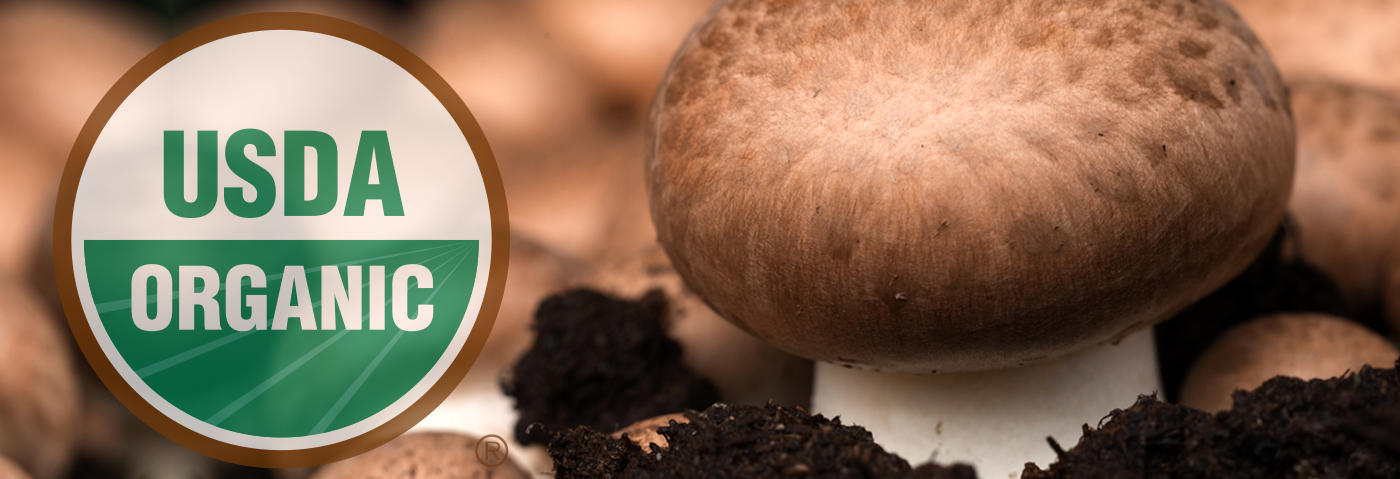
Organic Mushroom Industry Expands To Meet Rising Consumer Interest
- by Catharine Weber and Sharon Raszap Skorbiansky
- 7/17/2023
Consumers often view mushrooms as a nutritious food that is high in protein and essential amino acids. This favorable impression has contributed to increased consumption of organic mushrooms in the past decade. U.S. growers have expanded the area dedicated to organic mushrooms to meet rising demand, and to do so, they first must follow the standards set by USDA’s Agricultural Marketing Service, National Organic Program (NOP) to be certified as organic.
As part of the certification process, certain substances are prohibited from being applied to the land for at least 3 years before organic mushrooms can be harvested. The application of synthetic and nonagricultural materials is limited to products allowed by the NOP National List of Allowed and Prohibited Substances. For example, synthetic fertilizer cannot be used in the surface material on which mushrooms are grown (called the substrate). Gypsum (also known as calcium sulfate) can be added to soils if it has been mined but is not allowed if it has been synthetically produced. Organic mushroom growers are required to adhere to guidelines for controlling pests, weeds, and disease primarily through physical, mechanical, and biological means. Meeting organic production standards can result in higher production costs, and organic mushrooms typically are more expensive than conventional, nonorganic mushrooms.
Despite the associated higher costs of production, organic mushrooms have captured nearly 11 percent of the total mushroom production volume (as measured by the volume that growers sold as certified organic) in the 2021/22 marketing season (July–June). Most U.S. conventional and organic mushroom production consists of the genus known as Agaricus, which includes white button mushrooms, portabello, and crimini mushrooms. The specialty mushroom category includes varieties such as shiitake, oyster, and lion’s mane mushrooms. Agaricus mushrooms typically represent about 80 percent of organic mushroom volume produced by U.S. growers. While specialty mushrooms represent a smaller percentage of organic production volume, organic specialty mushroom production exceeded conventional specialty mushroom production volume in 4 of the 10 years between marketing years 2012/13 and 2021/22.
While the volume of U.S. organic mushroom grower sales has generally trended up since 2013, recent annual sales volumes fell below the record high set in the 2017/18 marketing year. Several factors influenced that trend. Tight labor supplies have challenged the ability for farms to produce year-round. The Coronavirus (COVID-19) pandemic further disrupted the market.
In recent years, imports of fresh mushrooms also have accounted for an increasing share of available domestic supply. There is no code available to differentiate organic mushroom imports from conventional, but total mushroom imports have offset decreases in U.S. production. Total imports of fresh mushrooms—largely from Canada—increased to 25 percent of the U.S. domestic supply in 2021/22 from 6 percent in 2001/02.
This article is drawn from:
- Davis, W.V., Weber, C., Lucier, G. & Raszap Skorbiansky, S. (2022). Vegetables and Pulses Outlook: December 2022. U.S. Department of Agriculture, Economic Research Service. VGS-369.
You may also like:
- Organic Agriculture. (n.d.). U.S. Department of Agriculture, Economic Research Service.
- Hadachek, J., Saitone, T.L., Sexton, R.J., Raszap Skorbiansky, S., Thornsbury, S. & Effland, A. (2022). Organic Feed Grains and Livestock: Factors That Influence Outcomes in Thinly Traded Markets. U.S. Department of Agriculture, Economic Research Service. ERR-303.
- Carlson, A., Greene, C., Raszap Skorbiansky, S., Hitaj, C., Ha, K.A., Cavigelli, M., Ferrier, P. & McBride, W.D. (2023). U.S. Organic Production, Markets, Consumers, and Policy, 2000–21. U.S. Department of Agriculture, Economic Research Service. ERR-315.


